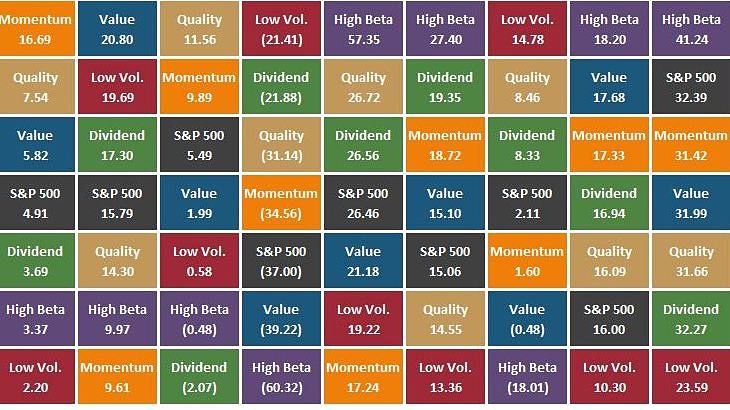Was the low volatility factor “broken” during the underperforming years? Is it broken now? We do not believe this is the case. In fact, we continue to believe the low volatility factor will outperform the S&P 500 index over the long term. Investors committed to the low volatility factor may be rewarded for their patience over the long term. However, many less committed investors will not enjoy the seasons with good weather for low volatility because they will not survive the gloomy seasons for this factor. Given that factors have periods of underperformance and outperformance points to the need for additional approaches that attempt to capture factor premiums.
Investors can “blend” factor exposures by investing in ETFs based on indices that diversify across factors. For example, State Street offers the SPDR MSCI USA Strategic Factors ETF (QUS) that equally weights the value, minimum volatility, and quality factors. Several other ETF providers provide factor blending solutions. This is a robust approach that may deliver outperformance by blending factors, but it may also dilute the better performing factors by including factors that are “out of season.” Factor blending assumes the long-term outperformance of factors relative to the benchmark.
An alternative method to capitalize on factor “seasons” is to employ a factor rotation strategy. At Lunt Capital, we adopt this approach and it creates the potential to adapt to the factor that is “in season” or the factor the market is favoring (LVHB). This approach, however, introduces strategy risk, or the risk that the rotation strategy is unsuccessful. Significant dispersion across factors highlights the opportunity that exists for factor rotation.
It is worth noting a recent quote from Ben Fulton, CEO of Elkhorn Investments. Ben was the managing director at Invesco PowerShares when the firm launched the S&P 500 Low Volatility ETF (SPLV). In a recent interview, Ben remarked, “The majority of factor ETFs aren’t really designed to be long-term buy-and-hold; they’re access products. You’re accessing a part of the market where you either feel it’s undervalued, there’s opportunity or better risk management.”
The high beta factor has not outperformed the S&P 500 on a “buy and hold” basis for the 15-year time period. However, it has had seasons of significant outperformance and underperformance. This highlights its use as an “access product” for factor rotation. Factor rotation does not depend on the long-term outperformance of individual factors, but rather on continued wide dispersion between factors.
It is reasonable to conclude that low volatility is not a buy and hold strategy. This is not because it is unlikely to outperform over the long term, but rather because few investors are likely to survive multiple years of underperformance. Recent months have witnessed money flowing out of the low volatility and minimum volatility ETFs. Is this money flowing into different factor ETFs, or is it moving back to the market cap-weighted ETFs? Rather than abandoning factors during their periods of underperformance, investors may want to consider the opportunities that exist in factor blending and in factor rotation.

